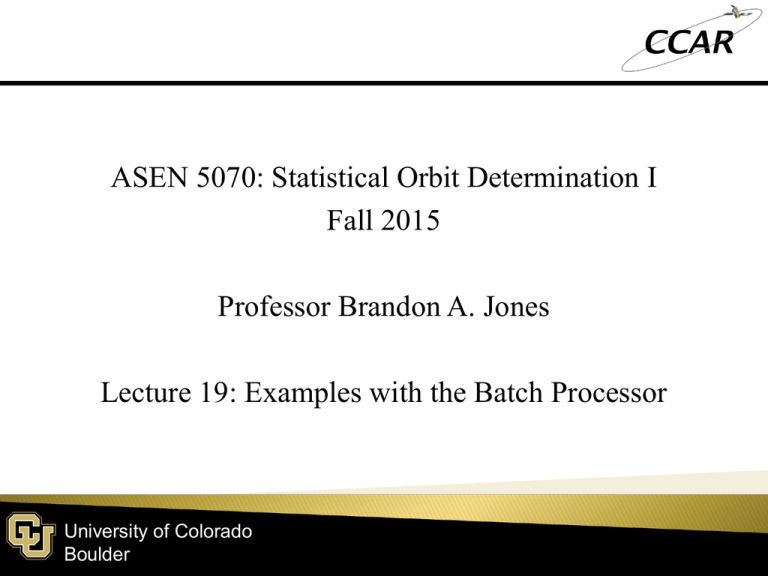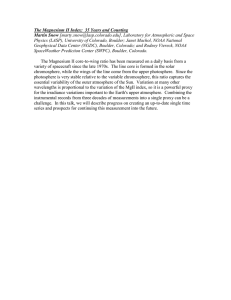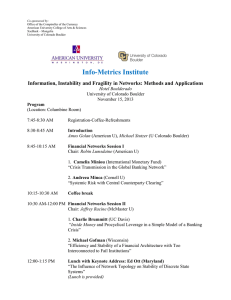ASEN 5070: Statistical Orbit Determination I Fall 2015 Professor Brandon A. Jones
advertisement

ASEN 5070: Statistical Orbit Determination I Fall 2015 Professor Brandon A. Jones Lecture 19: Examples with the Batch Processor University of Colorado Boulder Exam 1 – Friday, October 9 ◦ Any exam related questions? My office hours today in CCAR Meeting room instead of ECNT 420 University of Colorado Boulder 2 Everyone did well on these two quizzes All answers are included in the slides as an appendix, but we will only go over two questions from Quiz 4 University of Colorado Boulder 3 Percent Correct: D2L Error Consider the observation-state equation: In the case of a nonlinear estimation problem, which of the following are true: ◦ The observation-state relationship is linear with respect to deviation vectors ◦ The observation-state relationship is linear with respect to the nonlinear estimated state X ◦ We require an a priori x (deviation vector) to estimate the state using least squares ◦ We require an a priori X (nonlinear state) to estimate the state using least squares University of Colorado Boulder 4 Percent Correct: 30% In the case of nonlinear estimation using the linear batch filter, we attempt to estimate a state deviation vector x by solving for the vector that minimizes the sum of the observation residuals. By adding the state deviation vector to our best guess for the initial trajectory (X*), we get an updated state. To get this estimated state deviation vector, we require the observation deviation vector y. To solve for this, we use the predicted measurement G(X*,t). ◦ True ◦ False University of Colorado Boulder 5 Illustration – Object in Ballistic Trajectory University of Colorado Boulder 6 A cannonball has been launched with some uncertainty on the initial trajectory. We wish to: ◦ Estimate the initial state of the cannonball for future calibrations ◦ Determine where the cannonball went We have some observations near the peak of the trajectory. University of Colorado Boulder 7 Object in ballistic trajectory under the influence of gravity Start of measurements Start of filter University of Colorado Boulder 8 Object in ballistic trajectory under the influence of gravity Equations of motion: EOMs: Linear or Nonlinear? University of Colorado Boulder 9 Object in ballistic trajectory under the influence of gravity Observation Equations: Obs. Eqns: Linear or Nonlinear? Filter: Linear or Nonlinear? University of Colorado Boulder 10 Filter: Linear or Nonlinear? What do we need to solve via least squares? University of Colorado Boulder 11 How do we get the STM for this problem? University of Colorado Boulder 12 How do we get H_tilde for this problem? What is H ? University of Colorado Boulder 13 We have initial uncertainties on the a priori and the observations: University of Colorado Boulder 14 Pierson Correlation Coeffs University of Colorado Boulder 15 University of Colorado Boulder 16 University of Colorado Boulder Filter error smaller than measurement errors Why does the uncertainty decrease and then increase? 17 Predicted Illustrates error and 3σ bounds for data fit and prediction Filter Span University of Colorado Boulder 18 Should examine both the pre- and post-fit residuals: University of Colorado Boulder 19 University of Colorado Boulder 20 University of Colorado Boulder 21 Observation Equations: Station 2 Station 1 University of Colorado Boulder 22 How do we get H_tilde for this problem? University of Colorado Boulder 23 University of Colorado Boulder Filter error smaller than measurement errors Uncertainty decreases and then increases 24 University of Colorado Boulder Illustrates error 3σ bounds for data fit and prediction 25 University of Colorado Boulder 26 University of Colorado Boulder 27 University of Colorado Boulder 28 University of Colorado Boulder 29 University of Colorado Boulder 30 University of Colorado Boulder 31 Appendix: Lecture Quizzes University of Colorado Boulder 32 Lecture Quiz 4 University of Colorado Boulder 33 Percent Correct: D2L Error Consider the observation-state equation: In the case of a nonlinear estimation problem, which of the following are true: 89% ◦ The observation-state relationship is linear with respect to deviation vectors 25% ◦ The observation-state relationship is linear with respect to the nonlinear estimated state X 20% ◦ We require an a priori x (deviation vector) to estimate the state using least squares 20% ◦ We require an a priori X (nonlinear state) to estimate the state using least squares University of Colorado Boulder 34 Percent Correct: 30% In the case of nonlinear estimation using the linear batch filter, we attempt to estimate a state deviation vector x by solving for the vector that minimizes the sum of the observation residuals. By adding the state deviation vector to our best guess for the initial trajectory (X*), we get an updated state. To get this estimated state deviation vector, we require the observation deviation vector y. To solve for this, we use the predicted measurement G(X*,t). ◦ True ◦ False University of Colorado Boulder 35 Percent Correct: 93% Consider the weighted least-squares cost function J(x). We have two observation errors e1 and e2. The weights for those observations are w1=3 and w2=2. Which of the following provides the best solution? ◦ ◦ ◦ ◦ e1=1, e1=2, e1=1, e1=1, e2=1 e2=1 e2=2 e2=1/2 University of Colorado Boulder 36 Percent Correct: 84% In the weighted least-squares estimator, the H matrix no longer needs to be full rank. ◦ True ◦ False University of Colorado Boulder 37 Percent Correct: 91% For a linear estimation problem solved via the batch filter, we require a priori information to obtain a solution. ◦ True ◦ False University of Colorado Boulder 38 Lecture Quiz 5 University of Colorado Boulder 39 Percent Correct: 95% The inverse of the variance-covariance matrix is symmetric ◦ True ◦ False University of Colorado Boulder 40 Percent Correct: 76% Which of the following lists of numbers has the largest variance? A: [ 0.0, 0.5, 1.0 ] B: [ 0.0, 0.25, 0.5, 0.75, 1.0 ] C: [ 0.0, 0.1, 0.2, 0.3, … , 0.8, 0.9, 1.0 ] ◦ ◦ ◦ ◦ A B C They all have the same variance University of Colorado Boulder 41 Percent Correct: 86% If X and Y are independent random variables drawn from the standard normal distribution and Z = X+Y, which of the following best describes the probability density of Z? ◦ ◦ ◦ ◦ U(0,1) (uniform distribution with U(0,2) (uniform distribution with A normal distribution with mean A normal distribution with mean University of Colorado Boulder range [0,1]) range [0,2]) 0.0 1.0 42 Percent Correct: 90% If X is the number of people who fall asleep during an average ASEN 5070 lecture and “X” is drawn from U(0,2), then what is the expected value for the total number of instances of people falling asleep after 42 independent lectures? ◦ ◦ ◦ ◦ 0 16 30 42 University of Colorado Boulder Incorrect, but brownie points awarded! 43 Percent Correct: 88% ◦ Let f(x) be a probability density function. Which of the following are true? 90% 98% 2% 100% University of Colorado Boulder 44


